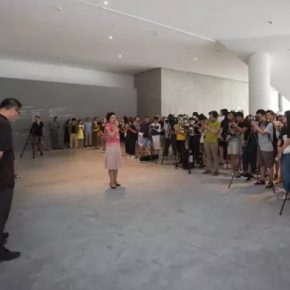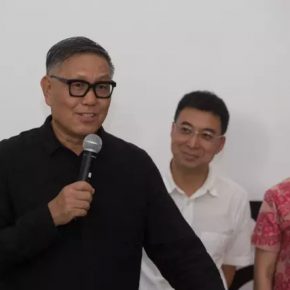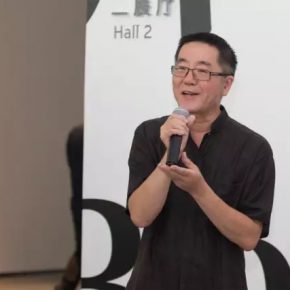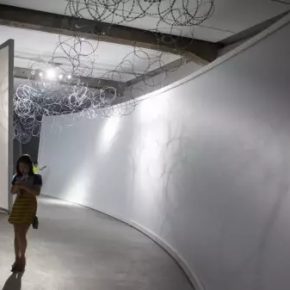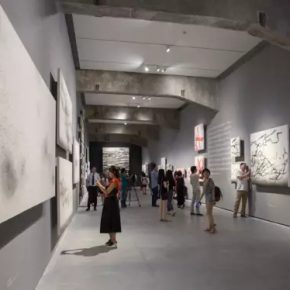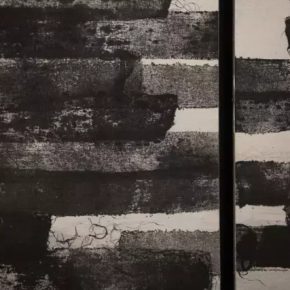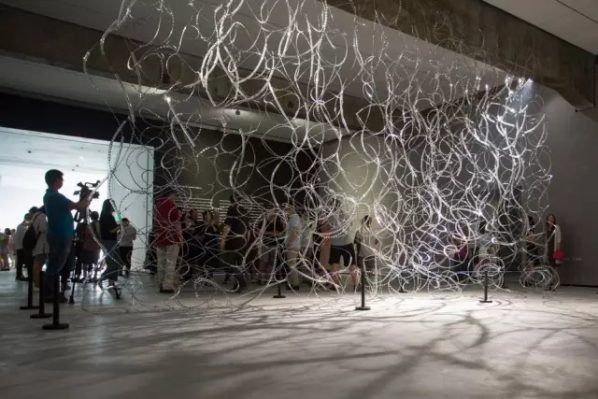
Having started at the Guangdong Museum of Art and was at the CAFA Art Museum, Wang Huangsheng is one of the major scholars and practitioners of all academics of the art museums in China, and Wang Huangsheng has retired as the director of CAFA Art Museum in the first half of this year, although the people in the art circles are still accustomed to calling him “Director Wang”, he has begun his own conversion of an identity. Wang Huangsheng was interviewed by CAFA ART INFO and said that, he would like to spend more time teaching and in artistic creation after leaving the post. At 3 pm on August 10, 2017 (Thursday), jointly organized by the China Minsheng Bank, Beijing Minsheng Art Museum, the Central Academy of Fine Arts, CAFA Art Musem, co-organized by the Beijing Minsheng Cultural Foundation, planned by the famous art historian Prof. Wu Hung, Wang Huangsheng: Boundary/Space grandly opened at the Beijing Minsheng Art Museum.
This exhibition brings together the major works of artists from recent years, including the “Moving Visions”, “Threading Apparition”, “Mark · Visions”, “Proverbs” and “Wall”, as well as several large-scale installations of video, such as “Boundary”, “Winding No. 2”, “Overflowing Light”, “Separating No. 2”, which were specially created depending on the exhibition space. A considerable part of the work was created by the artist when he served as the Director of CAFA Art Museum, reflecting his artistic thinking at that stage.
The theme of the exhibition stemmed from the artist’s continuous questioning of the “Boundary/Space”. Boundary is a limit, both containing the suspicion of existing rules and ideological contradictions, and it is also the external manifestation of all historical and power driven discourse, including territory and ideology. The problem of space is divided into two parts in the creation of the artist: on the one hand, the artist’s long-standing concern and reflection on the historical themes and realistic themes that “failed the sensory”; on the other hand, from the easel to the installation, the transformation and exploration of the graphic dots and lines are replaced by the 3-dimensional vision of space. The curator Wu Hung believes that, “‘crossing the boundary’ is both seductive and dangerous, because any boundary is always guarded by customs and conventions, for the boundary itself is an area that denies security. Wang Huangsheng’s work is full of poetic lyricism because of its continuously flowing lines, and it is also through the flowing instability that psychological tension can be stimulated and anxiety about the transformation created. This tension and anxiety is enlarged by some key details, so that the abstract lines become the metaphors of historical memories and the politics of reality”, while “Wang Huangsheng’s abstract art is always concrete and real, gaining life both from the reflection on the concept, as well as the care of history and reality.”
Over the years, Wang Huangsheng, as an artist, a director of art museums, museums and a scholar of art history, has multiple identities. His artistic creation is often mixed with the traditional literati’s accomplishment and the independent uninhibited spirit of breaking through, as well as modern intellectuals’ deep concern and intervention in culture, reality and historical issues, so that his artistic creation does not showcase an elegant culture and amazing visual characterization, but through the reconstruction of cultural memory is able to re-examine the political and multicultural reality in a global context, and allows people to be alert to the current overstepping actions of reality.
Wang Huangsheng has held solo exhibitions at various cultural institutions and art museums at home and abroad. His works are collected by the Ashmolean Museum, University of Oxford, the British Museum in UK, the V & A Museum in UK, Uffizi Museum in Italy, as well as National Art Museum of China and Suzhou Museum. Wang was awarded the “Literature and Art Knight Medal” by the French government and “Star of Italian Solidarity Knight Medal” by the Italian government. Wang Huangsheng is a professor of the Central Academy of Fine Arts, doctoral tutor.
On the opening day of the exhibition, an academic symposium was held. The curator Wu Hung, Guo Xiaoyan, Deputy Director of Beijing Minsheng Art Museum hosted the seminar, and the honored guests attending the seminar include Fan Di’an, Yin Ji’nan, Wu Liang, Feng Yuan, Shu Kewen, Zhu Qingsheng and Wang Min’an.
This exhibition has also been supported by Beijing ZHC Cultural Development Co.,Ltd., and 3812 Gallery, Hong Kong. It is also the latest achievement of the artist’s case study by the Beijing Minsheng Art Museum, and the exhibition continues to September 9, 2017.
Text by Zhang Wenzhi, organizer
Photo by Hu Sichen, organizer
Translated by Chen Peihua and edited by Sue/CAFA ART INFO
About the Exhibition
Wang Huangsheng: Boundary/SpaceProducer: Zhou Xujun
Curator: Wu Hung
Seminar Managers: Wu Hung, Guo Xiaoyan
Organizers: China Minsheng Bank, Beijing Minsheng Art Museum, Central Academy of Fine Arts, CAFA Art Museum
Co-organizer: Beijng Minsheng Foundation for Arts and Culture
Dates: August 10 – September 9, 2017
Venue: Beijing Minsheng Art Museum Hall 2
Supporters: Beijing ZHC Cultural Development Co.,Ltd., 3812 Gallery, Hong Kong
About the Artist
Graduated from Nanjing University of the Arts, Wang Huangsheng is a Doctor of Fine Arts. Now he is a professor of the Central Academy of Fine Arts, doctoral tutor, a member of the Academic Committee of the Central Academy of Fine Arts. He is a visiting professor of the University of Heidelberg, Germany, and a Distinguished Professor of Guangzhou Academy of Fine Arts and Nanjing University of the Arts.
Wang was awarded the “Literature and Art Knight Medal” by the French government, “Star of Italian Solidarity Knight Medal” by the Italian government, the title of “Beijing Outstanding Educator”.
Wang held solo exhibitions in the art museums and galleries in Beijing, Guangzhou, Shanghai, Suzhou, Nanjing, Wuhan, Hangzhou, Taiwan, Hong Kong in China, as well as Berlin, Heidelberg in Germany, London in UK, and Sydney in Australia.
His works are collected by the British Museum, V & A Museum in UK, Uffizi Museum in Italy, Mantova Museum in Italy, Ashmolean Museum, University of Oxford, Hoffman Collection Hall, Germany, as well as National Art Museum of China, CAFA Art Museum, Guangdong Museum of Art, Zhejiang Art Museum, Hubei Museum of Art, Guangdong Provincial Museum, Anhui Provincial Museum, Suzhou Museum, and the Art Museum of Nanjing University of the Arts.
His publications include a variety of monographs such as “Art Museum as Knowledge Production”, as well as more than 10 personal collections and exhibition catalogs, such as “Heaven and Earth ? Leisurely”, “Post-Aesthetic Mood”, “Boundless”, “Roaming on the Blades”, “Mediocrity”, “The Garden of Mystery”.
He was the former Director of the Guangdong Museum of Art, former Director of CAFA Art Museum. He founded and planned “Guangzhou Triennial”, “Guangzhou Photography Biennale”, “CAFAM Biennale” and “CAFAM Future” exhibition, “Beijing Photo Biennale”. He curated the “Art Documentary of Mao Zedong’s Era (1942-1976)”, “Humanism in China · Documentary in Contemporary”, “Social Sculpture: Beuys in China” and other large-scale exhibitions.
About the Curator
Wu Hung was a famous art historian, a professor at the University of Chicago. In 1963, he was admitted to the Department of Art History, Central Academy of Fine Arts, and worked in the Group of Chinese Painting and Calligraphy, the Group of Epigraphy of the Palace Museum from 1972 to 1978, and then returned to the Central Academy of Fine Arts for a master’s degree in 1978. From 1980 to 1987, he studied at Harvard University, and received a double doctorate in art history and anthropology. He then taught at the Department of Art History, Harvard University, became a lifetime professor in 1994. He was employed to support the teaching and research projects of Asian art of the University of Chicago, took the chair of “Professor Vanderstappen, Harrie A of Special Contribution”. In 2000, he established the Center for East Asian Studies and served as the director, while also serving as the consultant and curator of the Smart Museum of the university in the same year.


